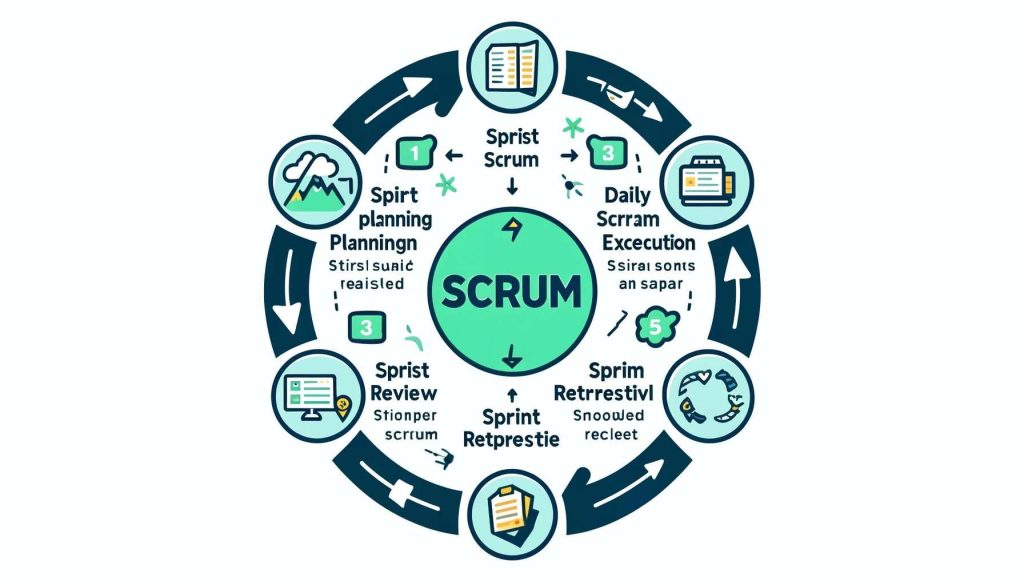Scrum, an agile framework widely embraced by software engineers, manages and enhances the development process effectively. Its primary objective is to bolster the flexibility and adaptability of project management, rendering it suitable for projects that undergo rapid changes and require a sense of urgency. The Scrum model focuses on teamwork, accountability, and iterative progress toward a clear target. The framework divides the development process into clear phases called Scrum ceremonies, each serving a specific purpose and providing unique value to the project’s life cycle. In this post, we will look at the different phases of Scrum Development and their contribution to the success of software development projects.
Phases of Scrum Development

Phase1. Sprint Planning:
- Objective
The objective of this phase is to organize the tasks that need to be performed during the sprint.
- Description
During the first phase of Scrum development, the team collaborates to determine the sprint’s goals and objectives. The team creates a backlog of tasks to be completed and prioritizes them based on their importance and complexity. Setting realistic goals for the sprint and ensuring that all team members understand their responsibilities is important.
- Tips
- Ensure that all team members actively attend the sprint planning process.
- Reduce the number of tasks and set them up as manageable units to enhance efficiency.
- Constantly communicate with team members to address any issues or problems that may arise.
Phase2. Daily Scrum
- Objective
In the next 24 hours, synchronize activities and draw up a plan.
- Description
Once the sprint begins, the team will engage in daily stand-ups to discuss progress, challenges, and plans for the day. These stand-ups are essential to promoting transparency and accountability within the team. To find solutions, each team member should provide updates on tasks, identify obstacles, and work with others to find solutions.
- Tips
- Keep daily stand-ups short and concise to maximize productivity.
- Support the transparentness of the progress and challenges of the team members.
- To celebrate achievements and motivate team members, use daily stand-ups.
Phase3. Sprint Execution
- Objective
To complete the work carried out during the preparatory phase of the sprint
- Description
During this phase, the team is working on the tasks identified in the Sprint backlog. The aim is to complete the tasks while maintaining flexibility so that the team can adapt when necessary. The team members work closely together, often in a shared environment or using online collaboration tools if they are remote.
Phase4. Sprint Review
- Objective
If necessary, check the increase and adjust the Product Backlog.
- Discription
At the end of the sprint, the team presents the final work to interested parties. This is a preliminary meeting to demonstrate the achievements and gather feedback relevant to the next sprint. Stakeholders have the opportunity to see the progress made and make necessary adjustments to the backlog.
- Tips
- To obtain valuable feedback from interested parties and support the transparent dissemination of information throughout the sprint review.
Phase5. Sprint Retrospective
- Objective
Review and improve the team process.
- Discription
This phase occurs after the sprint plan review and before the next sprint plan. It is a meeting where the team discusses what has been going well, what needs improvement, and how to enhance the next sprint. Continuous improvement is essential for Scrum’s agile and efficient nature.
- Tips
- Use this retrospective as an opportunity to evaluate what has been done well and identify areas for improvement.
- Implement changes based on retrospective feedback to enhance the team’s performance continuously.
The types of projects suited to the Scrum Methodology
Scrum methodology can be applied to a wide range of projects, particularly those that are complex, uncertain, or require high levels of collaboration. Examples of projects that can benefit from Scrum include:
Software Development Projects
Scrum is widely used in software development, where projects often involve changing requirements, tight deadlines, and frequent releases. Scrum enables software development teams to deliver working applications and rapidly respond to user feedback.
Product Development Projects
The Scrum methodology can also be advantageous for product development projects in which teams are tasked with designing and introducing new products. By implementing Scrum, product development teams can effectively iterate on their designs, gather valuable customer feedback, and swiftly make necessary improvements.
Marketing Campaigns
Scrum is a valuable tool for managing marketing campaigns, particularly when teams are required to collaborate on creating and launching new campaigns across various channels. By utilizing Scrum, marketing teams can effectively align their objectives, monitor progress, and make necessary adjustments to optimize campaign performance.
Research and Development projects
Furthermore, the Scrum methodology is highly suitable for research and development projects, especially those focused on experimentation and innovation. It enables teams to explore hypotheses swiftly, collect data based on results, and adapt their approach accordingly.
Conclusion
Effective communication, collaboration, and adaptability are necessary to navigate the phases of Scrum development. Teams can successfully execute projects and deliver high-quality results by applying these principles and understanding the importance of each stage. The key to the success of Scrum is continuous improvement.




